[D. W. Karn & Co. Advertising Fan]. London, Ont: London Printing & Litho. Co., 1896-1909.
Like some of the ASC items highlighted last month, this piece is ephemeral in nature, but it also has the distinction of being closer to an object than a book . Cataloguing standards allow for the cataloguing of non-book items such as maps, audio-visual materials, music, computer files, kits, and like in this case, three dimensional artefacts, specifically, a fan.
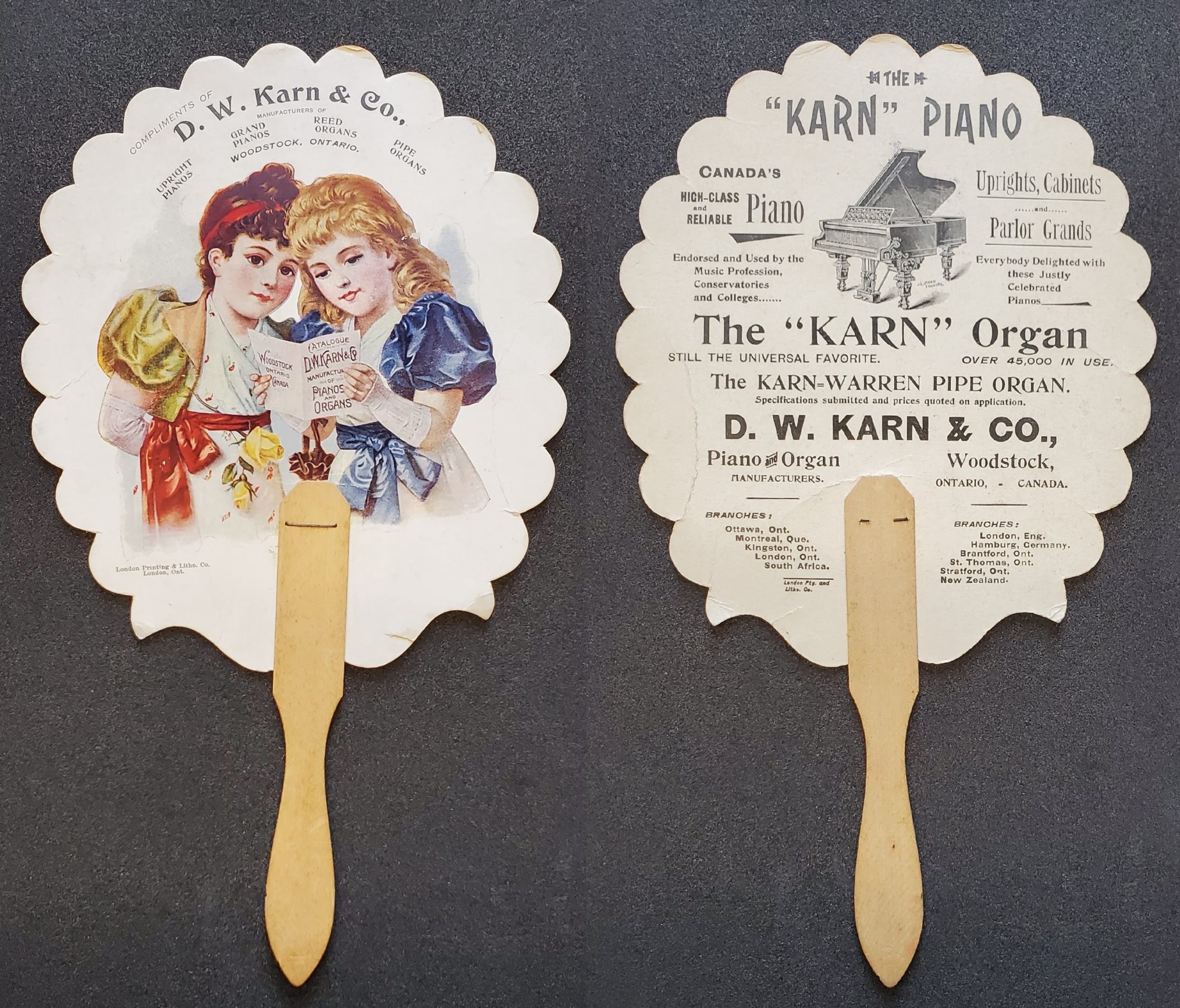
This fan was created to advertise or D.W. Karn & Co., a piano and organ manufacturer. The business was established by Dennis W. Karn and John M. Miller in 1867 at The Woodstock Organ Factory, soon changed to Miller and Karn. Miller was bought out in 1870 by Karn and the firm was renamed to D.W. Karn & Co., Ltd. in 1873. In 1896 D.W. Karn purchased S.R. Warren Piano Company of Toronto, then in 1909 the company merged with The Morris Piano Company and became The Karn-Morris Piano and Organ Company. In 1924 Sherlock Manning purchased the firm and continued making pianos until 1961.
Cataloguing items such as these presents their own set of challenges, most of which require information to be provided by the cataloguer. First, naming, there is no real title to this work, so the title must be devised by the cataloguer. Next is publication information which was luckily partially printed on the item, specifically that it was printed in London, Ontario by the London Printing and Lithography Company. The last piece of information is a date of creation, which this item is missing. When no exact date is possible, providing a date range is often the next best option.
The company name on the fan is D.W. Karn, immediately placing the fan after 1873, when the name of the business was changed from Miller and Karn. It also could not have been made after 1909, when the name of the firm became The Karn-Morris Piano and Organ Company. To further narrow down the date, I then looked at the products advertised on the fan. The "Karn-Warren Pipe Organ" began production in 1897, narrowing down the production of the fan to a twelve year period. While not exact, an approximate date provides researchers with better information so that they can make better decisions about which items they come in to see.
Cruikshank, George. “The Rights of Women” or the Effects of Female Enfranchisement. London: D. Boque, 86 Fleet Street, 1853.
This etching by George Cruikshank (1792-1878) was one of several he created for The Comic Almanack, which ran from 1835 to 1854. Cruikshank started his career by making political cartoons before eventually becoming a successful book illustrator. Most notably he illustrated stories for Charles Dickens, including Sketches by Boz and Oliver Twist. Cruikshank also began his own publication, The Comic Almanack, in 1835 while continuing to illustrate for other authors. The almanac was released once a year and contained approximately 64 pages and twelve etchings (later only six to save costs), each meant for a particular month.
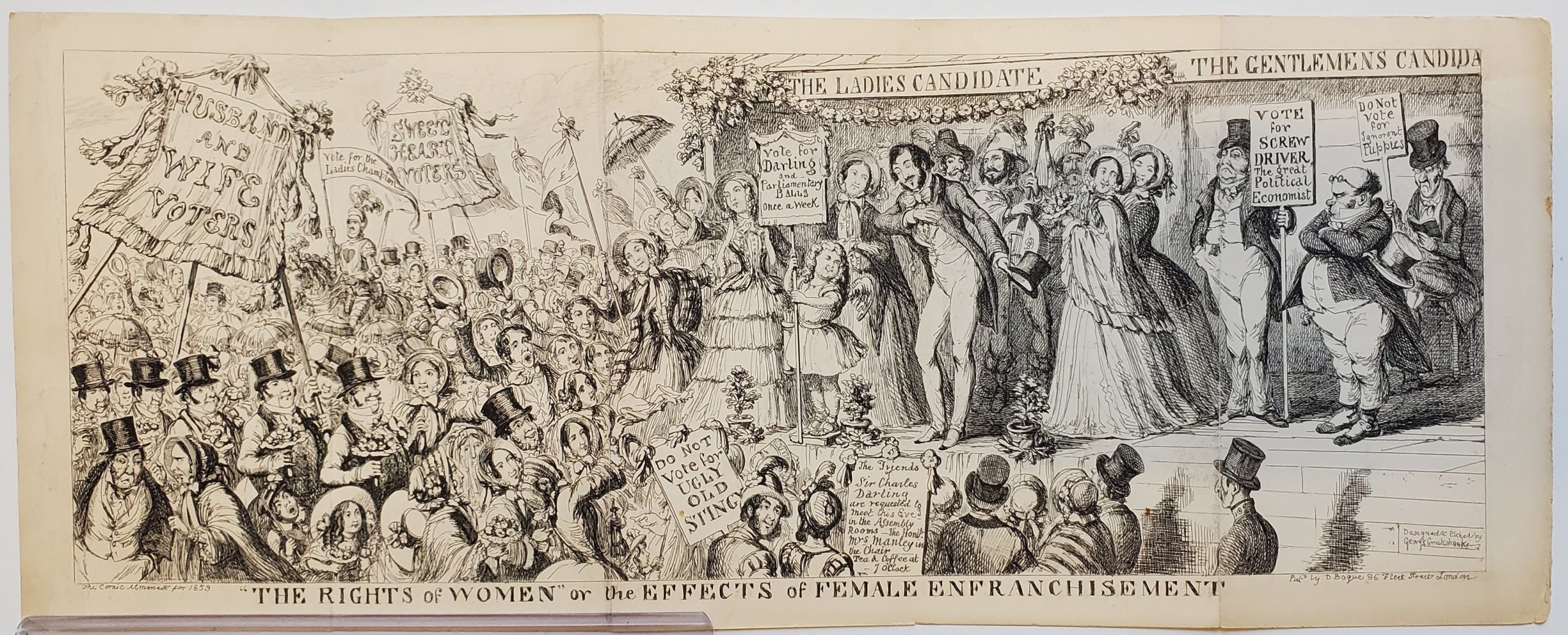
Etching is a process of printing in which a metal plate is covered with ground (either wax or varnish) then the printmaker scratches away parts of the ground to expose the metal underneath. The plate is then dipped in acid and the exposed metal is eaten away while the metal covered by the ground remains intact. The result is recesses in the exposed metal that can retain ink for printing. Tones can be created from multiple baths and covering the plate with ground to protect lighter areas. The plate must go through a rolling printing press to press the paper into the incised lines filled with ink. This printing is a separate process from letterpress printing. Etchings set this almanac apart from other comic almanacs which typically used wood engravings. However, it also made the publication more expensive, which, along with the increasing popularity of other comic almanacs like Punch, led to The Comic Almanack's decline in the 1850s.
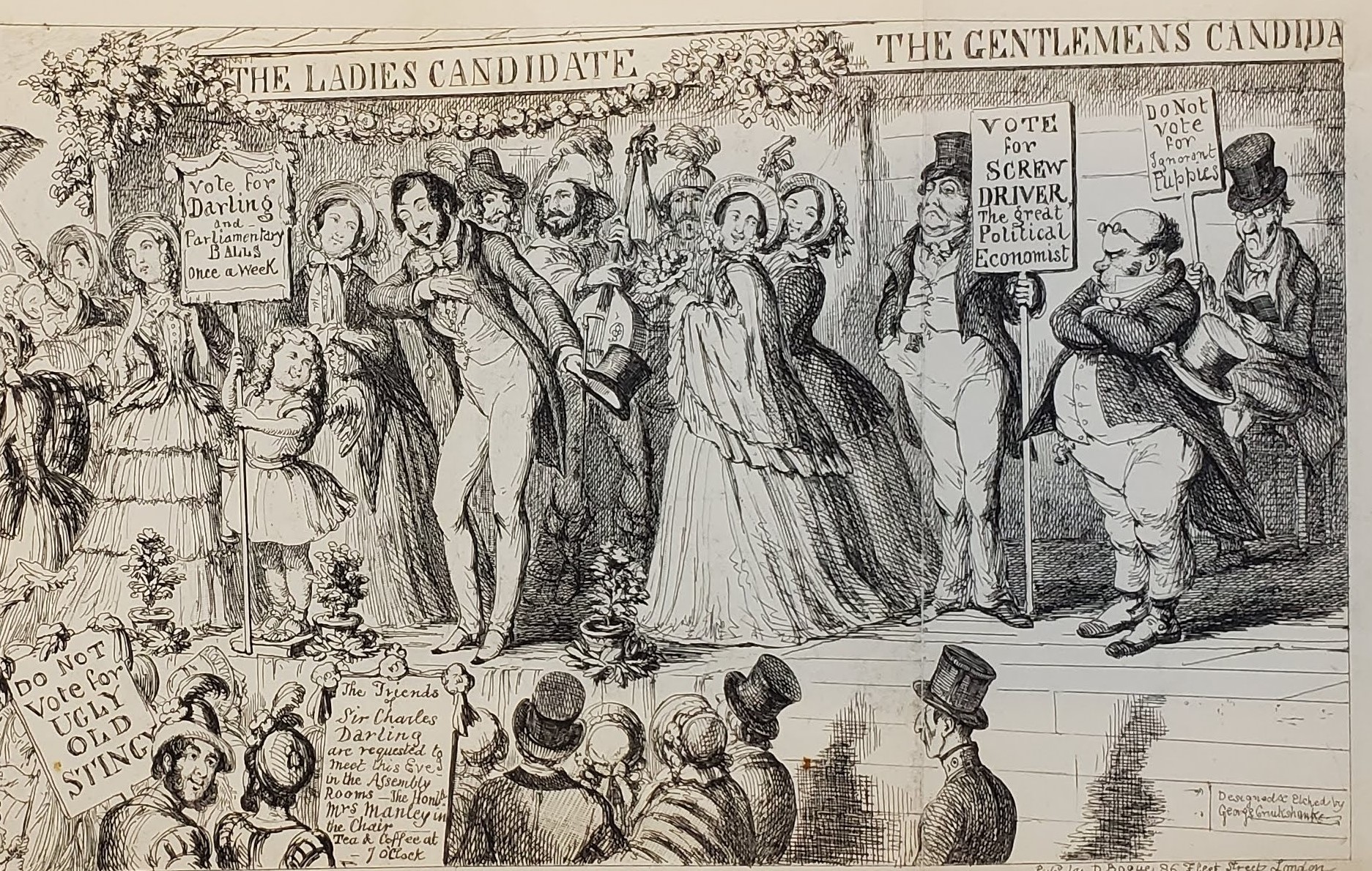 Almanacs were read by every social level and they contained useful information about the year, but they also commonly had wild predictions and anecdotes. Pirated almanacs were also common in the early nineteenth century. As the working class began to read more, reformists in the 1820s attempted to end the superstitious predictions to make almanacs authoritative sources of information. Comic or travesty almanacs like The Comic Almanack were satirical responses to the idea of using print to influence the people who read it.
Almanacs were read by every social level and they contained useful information about the year, but they also commonly had wild predictions and anecdotes. Pirated almanacs were also common in the early nineteenth century. As the working class began to read more, reformists in the 1820s attempted to end the superstitious predictions to make almanacs authoritative sources of information. Comic or travesty almanacs like The Comic Almanack were satirical responses to the idea of using print to influence the people who read it.
With this context in mind, it is difficult to determine Cruikshank's personal opinions on women's suffrage. He was known to make anti-reform pieces on commission, such as "Universal Suffrage, or, the Scum Uppermost" for George Humphrey, but later in life he was also commissioned to make the anti-alcohol series The Bottle. After this Cruikshank supported and became active in the Temperance Movement as a teetotaler, someone who believes in the total abstinence from alcohol. The movement was popular with women who wanted a vote on issues related to the home, seeing it as their religious and moral duty to protect it.
Salinger, J. D. (Jerome David). The Complete Uncollected Short Stories of J.D. Salinger. United States?: [publisher not identified], 1974.
J.D. Salinger is most famous for his novel The Catcher in the Rye, but from 1940 to 1965 Salinger published thirty short stories in magazines such as The New Yorker and Esquire. Of these, thirteen were collected and published in volumes during Salinger's lifetime. Twenty-two of these stories remained discoverable only in their original magazine publications. These stories included early versions of his Glass family in "The Varioni Brothers," stories such as "I'm Crazy" and "Slight Rebellion off Madison" which later became scenes in The Catcher in the Rye, and stories published before Catcher but reveal the future of its characters like "The Last Day of the Last Furlough" and "This Sandwich has no Mayonnaise." One of these twenty-two is the last story Salinger published, "Hapworth 16, 1924," a short story so harshly critiqued that after it Salinger stopped publishing all together.

In 1974 these twenty-two short stories were published in a two volume unauthorized edition without Salinger's consent. Salinger went on to tell the Times, "I wrote them a long time ago, and I never had any intention of publishing them. I wanted them to die a perfectly natural death." Salinger was known to have his representatives email booksellers if they attempted to sell something he objected to, like these pirated copies.
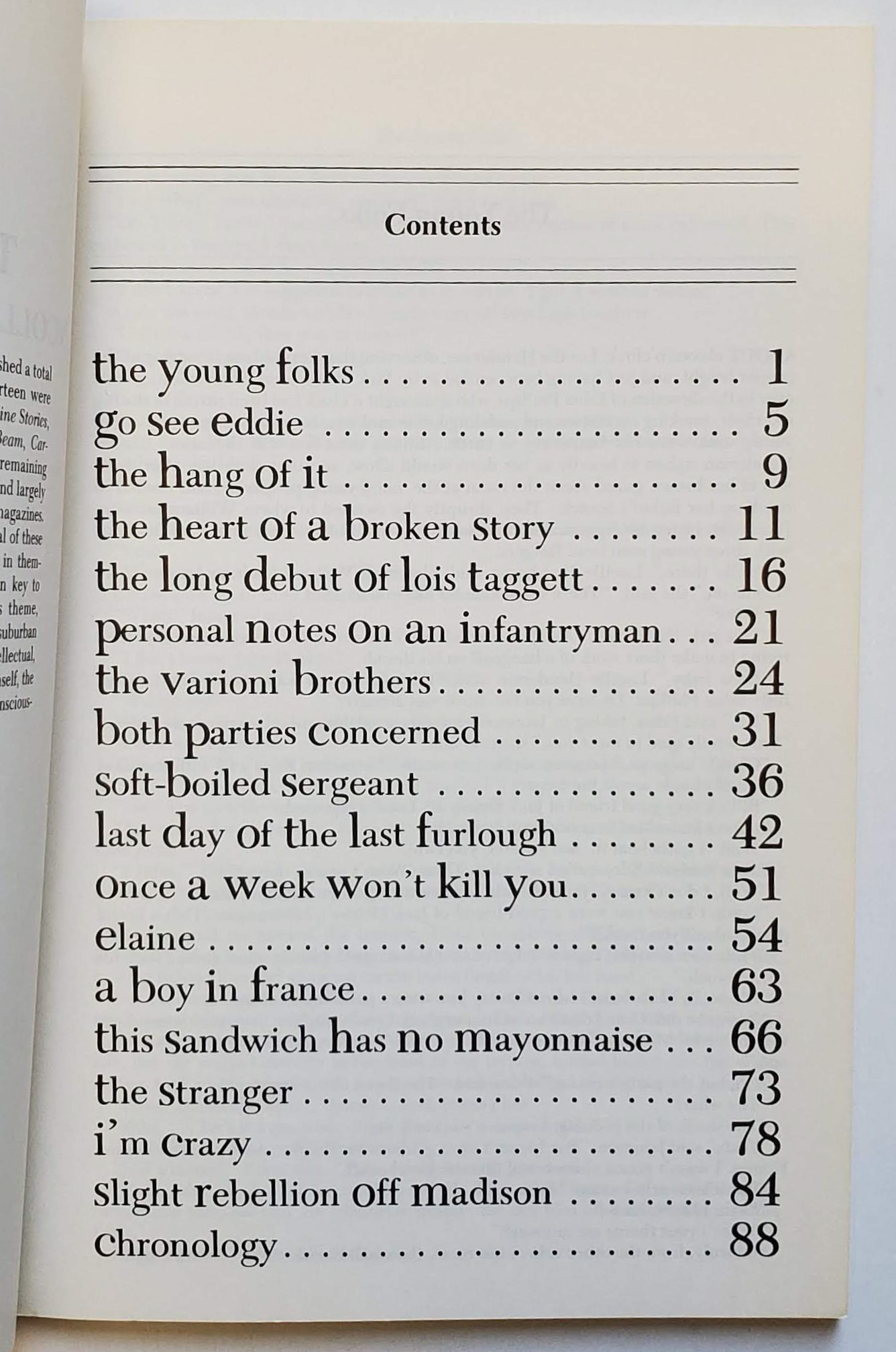 When first cataloguing these books I had no knowledge of any of this back story, but it did not take long to determine that these volumes did not go through the typical printing and publishing process. Upon initial inspection the mise-en-page (or text layout) had narrow margins and the typeface of the contents is inconsistent, but these could still be considered stylistic choices. The largest clue was the fact that there was no publishing information contained within either item. The page typically found on the reverse of the title page with copyright, publishing, and cataloguing information was completely missing. It is at this point that cataloguers are heavily indebted to the work of bibliographers who study books as an object. In enumerative bibliography bibliographers list books based on specific authors, topics, time period, or places. In this case, the work George Bixby in "J.D. Salinger: a bibliographical checklist" published in The American Book Collector listed all the books published with Salinger as an author and was instrumental in identifying these items as bootleg copies. Cataloguer's work is not done in a bubble and I will often check bibliographies against the copy I have in hand to correctly determine editions, if a copy is imperfect, or like in this case, find some publication details along with come contextual information.
When first cataloguing these books I had no knowledge of any of this back story, but it did not take long to determine that these volumes did not go through the typical printing and publishing process. Upon initial inspection the mise-en-page (or text layout) had narrow margins and the typeface of the contents is inconsistent, but these could still be considered stylistic choices. The largest clue was the fact that there was no publishing information contained within either item. The page typically found on the reverse of the title page with copyright, publishing, and cataloguing information was completely missing. It is at this point that cataloguers are heavily indebted to the work of bibliographers who study books as an object. In enumerative bibliography bibliographers list books based on specific authors, topics, time period, or places. In this case, the work George Bixby in "J.D. Salinger: a bibliographical checklist" published in The American Book Collector listed all the books published with Salinger as an author and was instrumental in identifying these items as bootleg copies. Cataloguer's work is not done in a bubble and I will often check bibliographies against the copy I have in hand to correctly determine editions, if a copy is imperfect, or like in this case, find some publication details along with come contextual information.
Bacon, William. Petition of Wm. Bacon, of the Village of Ogdensburgh, State of New York. Toronto: Printed by Lovell and Gibson, 1851.
The steamer the Sir Robert Peel was launched on May 5, 1837 in Brockville, Ontario. It was built for $10 000 through a partnership between three Canadians: Jonas Jones, David B.O. Ford, and Robert Harvey, as well as William Bacon of Ogdensburgh, New York. However, shortly after its launch, in the early hours of May 30, 1838 on the St. Lawrence River in the Thousand Islands region, the steamship sank in spectacular fashion. Stocking up with firewood, the Peel was attacked by men armed with bayonets and muskets. After all the passengers and crew were taken off the vessel, the Peel drifted before dropping anchor, and when the men were unable to restart the boilers, the ship was set on fire and the men escaped into the night. There have been many suggestions as to the reason behind the attack. Led by Bill Johnston and Donald McLeod, the attack was carried out in the larger context of the Patriot War, in which groups of raiders on the Canada-United States border were attacking Upper Canada in the hopes of overthrowing British rule. Johnston and McLeod were some of these raiders. Johnston was given instructions to foster war between the United States and Britain, but he may have also wanted revenge for the destruction of the ship the Caroline in December of the previous year.
The destruction of the Peel caused many to fear that war would indeed break out between the United States and Great Britain and rewards were quickly promised for the capture of the ringleaders and all those involved. However, by June 10 Johnston had not been captured, going so far as to write a letter to the editor of the Watertown Jeffersonian confirming his involvement. He was not caught until he surrendered following the Battle of the Windmill in November 1838. The ramifications of this battle also meant that many Canadians were who meant to testify at the trials of the men who had been captured were unable to attend, and those men were subsequently acquitted.
This new ASC acquisition meets this story in 1851 in the form of a petition by one of the original co-owners of the Sir Robert Peel to the Legislative Assembly of the Province of Canada. At this point all three Canadian investors in the Peel had received remuneration of £2348 19s 9d. William Bacon, though, was an American citizen who had never lived in the province and therefore according to the Commissioners this made him ineligible for payment. This petition appeals that decision, asking for the same remuneration for "an innocent Foreigner." Thirteen years after the sinking of the Peel the effects were still being felt by the community. No information is readily available on the Assembly's decision, which can be a common theme in special collections. Documents provide pieces to a story, and it often takes a researcher to put it all together.
Edwoods, William Henderson., Thomas. Williams, Newton. Carey, William Henry. Harris, and Peter McGill. Petition of William Henderson Edwoods and Others, Members of the First Colored Calvinist Baptist Church of Toronto. Quebec: Printed by Lovell and Lamoureaux, Mountain Street, 1855.
Edwoods, Mary Jane. Petition of Mrs. Mary Jane Edwoods and Others, Trustees and Members of the First Colored Calvinistic Baptist Church of Toronto, Praying That the Bill to Authorize Certain Alterations in Their Deed of Trust, May Not Become Law. Quebec: Printed by Lovell and Lamoureaux, Mountain Street, 1855.
The First Baptist Church, as it is known today, was founded in Toronto in 1826 by enslaved freedom seekers. It was both the first Baptist congregation in Toronto and the oldest Black institution in the city. Washington Christian was their first pastor, a former enslaved person who operated a house church for a year before the congregation rented their first space. In 1834 they moved to a building on March Street (later Lombard Street) with an increasing number of both former enslaved people and white Baptist immigrants from Great Britain and the United States. In 1841 the church received a gift of land and built a church on Queen Street, near the corner of Victoria Street. Around the same time white members of the congregation moved to another church, and First Baptist again became a predominantly black congregation. It was known at the time as the First Colored Calvinistic Baptist Church or the Queen Street Coloured Baptist Church.
Approximately fifteen years later this petition and counter petition were filed with the Legislative Assembly of Canada, and copies are now in ASC. The first, dated February 10th, 1855, requested that the church trustees be elected from the membership and have their term limited to one year. With close to 100 signatories there was clearly a movement within the church for change. However, just over a month later a counter petition to this previous petition was filed. Signed by a further 34 congregants it asks the Assembly not to pass a Bill to change the management of the Church. The deed to their Queen Street church had stipulated how church trustees were to be appointed and it argued that the current minister was responsible for the current distrust of this system. If the congregation were able to choose another pastor, the present issues would be solved. During this time the church actually split over disagreements (perhaps this very disagreement) and for over a decade a second congregation met on Teraulay Street.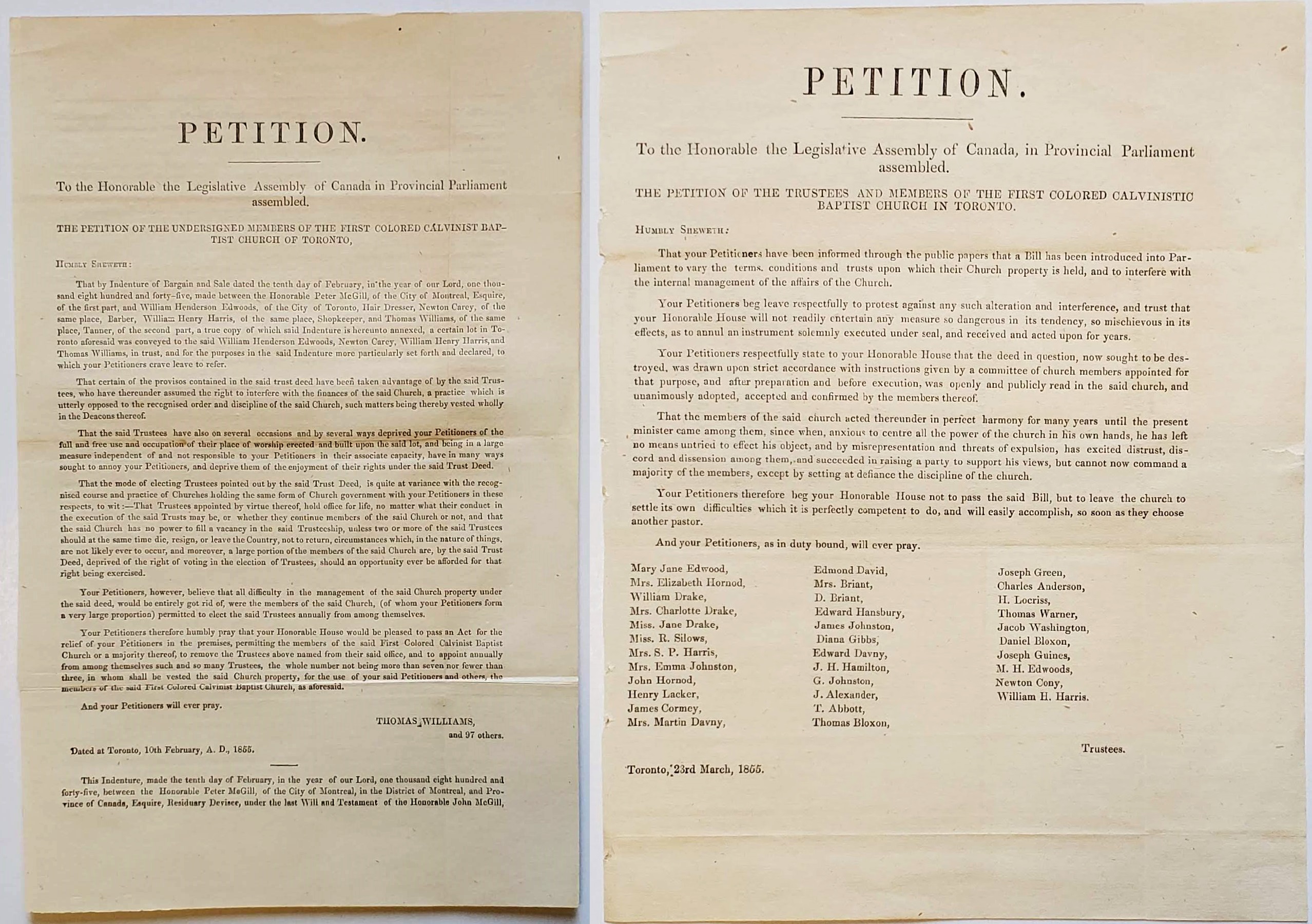
These two documents tell a fascinating story of a ministry and congregation trying to determine what kind of church they wanted to be, and how they wanted to govern. That on it's own, as well as its significance as a piece of Black history in Toronto make these important acquisitions. However, there was another aspect of these petitions that caught my eye, and I took on the role of researcher to reveal some personal stories behind these documents.
There were many names on these documents as signatories, but two names caught my eye. One of the main names on the original petition was William Henry Edwoods, and the first name on the counter petition is Mary Jane Edwood (Edwoods on the reverse title). It was only later that I noticed a third name, M.H. Edwoods on the counter petition. I now had three people with the same last name, and the name seemed too unique to be from unrelated people, so I did some research. 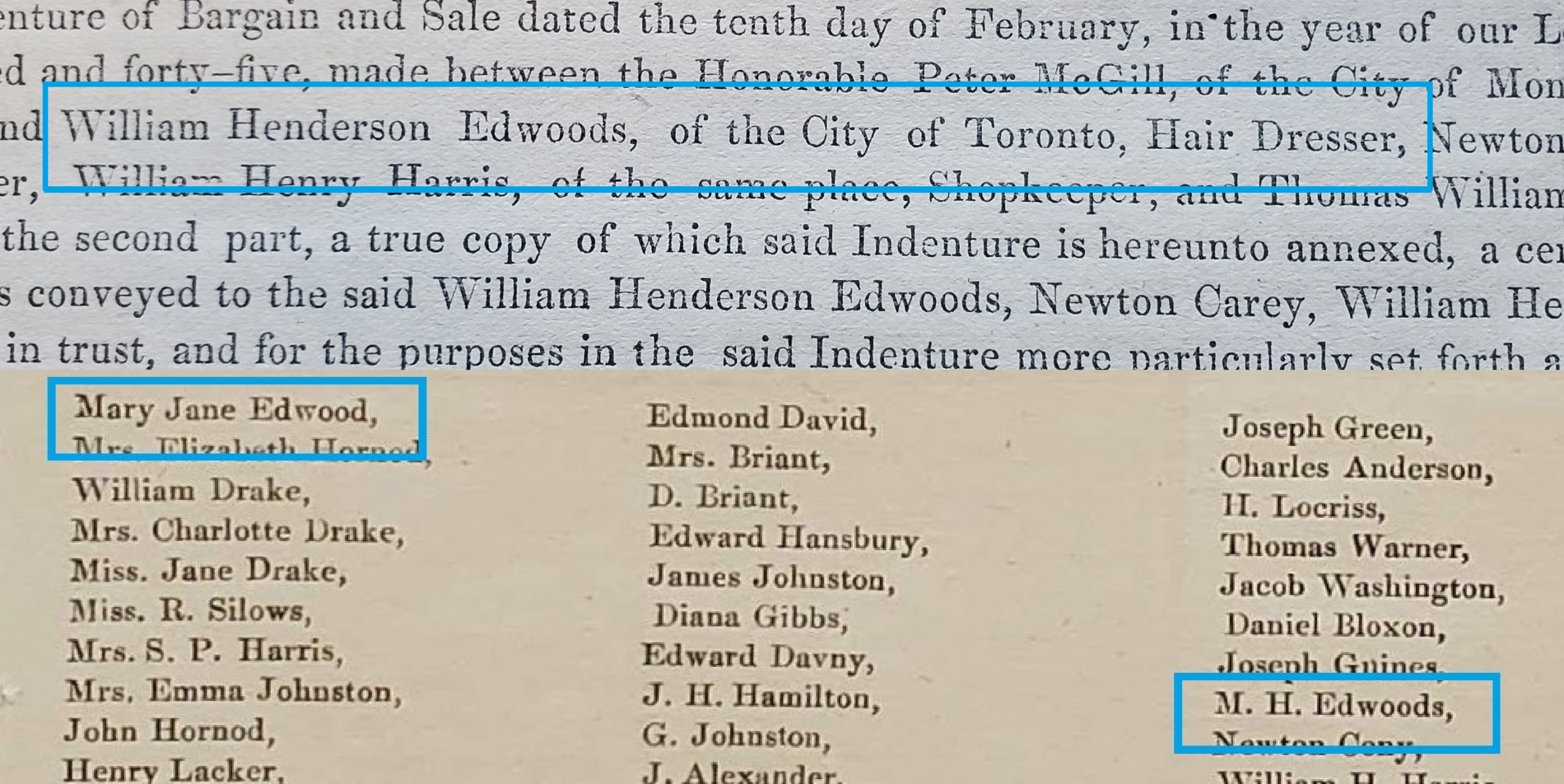
I went to the census for more answers. There were no relevant results in the 1851 census (perhaps they emigrated from the United States like so many others), but the 1861 census yielded results. Library and Archives Canada has digitized the 1851 and 1861 census from their microfilm, making them easily searchable. The name is so unique it only turned up one family located in the St. Lawrence Ward of Toronto. The head of household in the search results was labelled as a W.A. Edwoods, not a W.H. Edwoods. When I looked at the actual record though, it was clear this was in fact a W.H. Edwoods, the man I was looking for (perhaps emphasizing to always look directly at the source material). This was a 51 year old Black Baptist Hairdresser in Toronto, who lived with his 39 year old wife M.J. Edwoods. What appeared before me, from these formal and legal documents was the story of a couple and perhaps an entire family that was at odds about what the future of their church would look like. If they were heavily involved in the church, as these petitions suggest, it could have made for a very difficult situation.
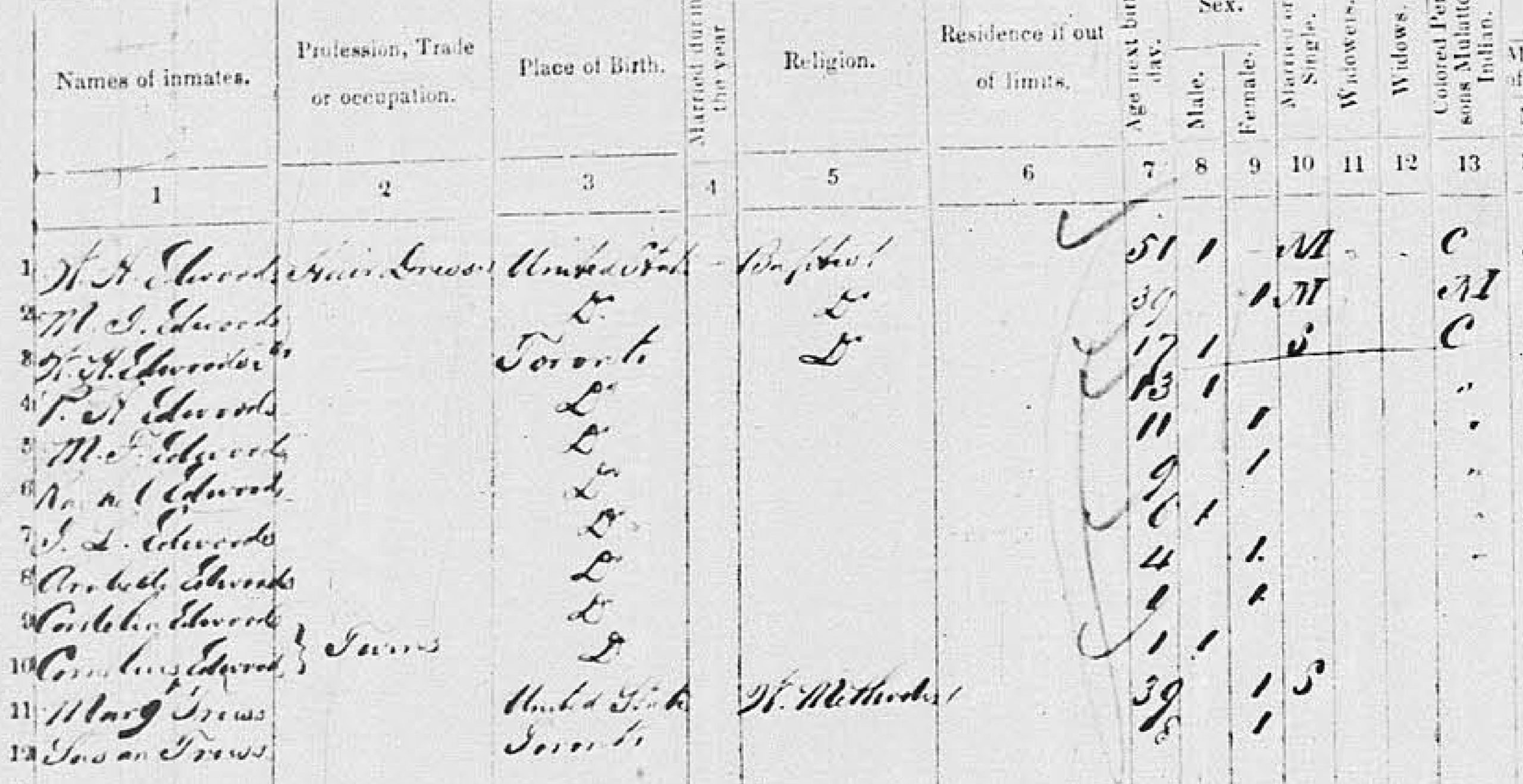
Courtesy of Library and Archives Canada
What I did not find was an M.H. Edwoods. Was it the 17 year old son on the census listed as W.H. Edwoods? It seemed unlikely as it would mean the son signed the counter petition at just eleven. Perhaps it was a family member who had died or moved prior to the census. Sometimes you can't have every question answered, but perhaps I will do some more digging.
Written by Taylor Tryburski
References
https://www.thecanadianencyclopedia.ca/en/article/karn-piano-co-ltd-emc
https://antiquepianoshop.com/online-museum/karn/
https://www.illustrationhistory.org/artists/george-cruikshank
Maidment, Brian. “‘Larks in Season’: The Comic Almanack (1835–54).” Cahiers victoriens & édouardiens 84, no. 84 Automne (2016): 14–14.
https://entertainment.time.com/2013/09/07/discovering-j-d-salingers-lost-stories/
https://www.betweenthecovers.com/btc/reference_library/author/1002772
McIntire, C.T. “Protestant Christians.” In The Religions of Canadians, edited by James S. Scott, 75-130. Toronto: University of Toronto Press, 2012.

